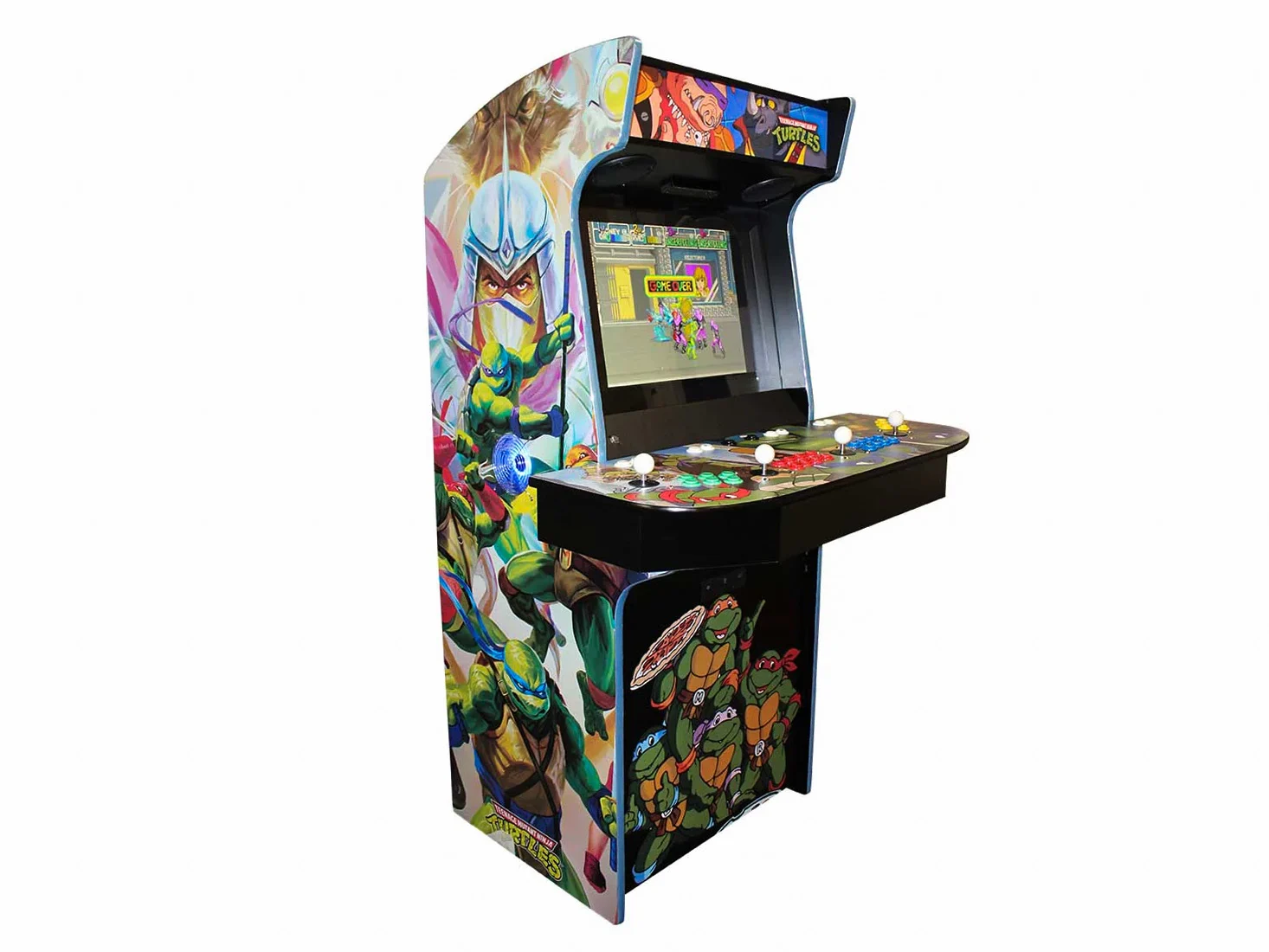Retro arcade machines evoke nostalgia for the golden age of gaming, transporting players back to the vibrant arcades of the 70s, 80s and 90s. These iconic cabinets, with their flashing lights, tactile joysticks, and pixelated graphics, remain a beloved part of gaming culture. Whether you’re a collector, enthusiast, or business owner looking to add a retro touch to your venue, this in-depth guide explores the history, types, costs, and practical considerations of retro arcade machines, answering every conceivable questions, if we’ve missed something drop a request in the comments section below.
The History of Retro Arcade Machines
Retro arcade machines trace their origins to the early 1970s, marking the dawn of video gaming. The first commercial arcade game, Computer Space (1971), introduced by Nolan Bushnell and Ted Dabney, laid the groundwork for the industry. However, it was Atari’s Pong (1972) that achieved mainstream success, sparking the arcade boom. The late 1970s to early 1980s, known as the “Golden Age of Arcade Video Games,” saw iconic titles like Space Invaders (1978), Pac-Man (1980), and Donkey Kong (1981) captivate players worldwide. These games, housed in coin-operated cabinets, became cultural phenomena, shaping gaming and popular culture.
The industry evolved with technological advancements, from black-and-white displays to vibrant colour screens and vector graphics (Asteroids, 1979). By the mid-1980s, arcades faced a decline due to market saturation and the rise of home consoles like the Nintendo Entertainment System. However, retro arcade machines have seen a resurgence in recent years, driven by nostalgia and demand for authentic gaming experiences in homes, bars, and entertainment venues.
Types of Retro Arcade Machines
Retro arcade machines come in various styles, each suited to different spaces and preferences:
- Upright Cabinets
- Description: Tall, freestanding machines (typically 170–180 cm high, 56–80 cm wide) with a monitor, joystick, and buttons. Iconic for games like Street Fighter II or Defender.
- Best for: Home game rooms, pubs, or arcades.
- Example: Arcade1Up’s Ms. Pac-Man upright cabinet.
- Cocktail Tables
- Description: Low, table-style machines (45–48 cm high, 90 cm wide) designed for seated play, often with two control panels for multiplayer.
- Best for: Living rooms or lounges with limited space.
- Example: Arcade Depot’s cocktail tables with 3,000+ games.
- Bartop Machines
- Description: Compact, countertop versions of upright cabinets, ideal for smaller spaces.
- Best for: Kitchens or offices.
- Example: Arcade1Up’s Pac-Man Jr. bartop machine.
- Multi-Game Machines
- Description: Modern recreations with thousands of pre-installed games, using emulators like MAME or Retro Cloud software.
- Best for: Versatile gaming with classics like Galaga and Frogger.
- Example: Bespoke Arcades’ GT Series with over 10,000 games.
- Speciality Machines
- Description: Include dance machines, light gun games (Time Crisis), or driving simulators.
- Best for: Unique experiences in larger venues.
- Example: Raw Thrills’ racing cabinets.
Why Are Retro Arcade Machines Popular Today?
The resurgence of retro arcade machines stems from nostalgia, collectability, and their appeal as statement pieces. Enthusiasts value the tactile experience of joysticks and buttons, which modern consoles can’t replicate. Businesses use them to attract customers, while families enjoy them as shared entertainment. Modern multi-game cabinets, offering thousands of titles, make them accessible and cost-effective.
Frequently Asked Questions About Retro Arcade Machines
Below is a comprehensive list of conceivable questions about retro arcade machines, with detailed answers tailored to enthusiasts, collectors, and businesses in the UK.
1. How Much Do Retro Arcade Machines Cost in the UK?
- Answer: Prices vary based on type, condition, and features:
- New Multi-Game Machines: £995–£5,000 (e.g., Bespoke Arcades’ GT Series or Arcade1Up’s deluxe cabinets).
- Refurbished Classics: £1,500–£3,000 (e.g., restored Space Invaders or Pac-Man cabinets from Liberty Games).
- Mini/Bartop Machines: £150–£500 (e.g., Basic Fun’s Tetris mini arcade at Argos).
- Custom-Built Machines: £2,000–£6,000+ with bespoke artwork or upgrades like light guns.
- Tip: Check for free delivery (common with retailers like Arcade Mania) and warranty options (e.g., Arcade Depot’s 12-month guarantee).
2. Where Can I Buy Retro Arcade Machines in the UK?
- Answer: Reputable UK retailers include:
- Liberty Games: Largest stockist with free delivery and tech support. Offers refurbished classics and multi-game machines.
- Arcade Mania: Hand-built machines with custom artwork, highly rated for customer service.
- Arcade Depot: Premium-grade machines with matching stools, 12-month guarantee.
- Bespoke Arcades: Luxury cabinets with Retro Cloud software, starting at £995.
- Home Leisure Direct: Wide range of retro and modern machines with finance options.
- Argos: Affordable mini arcade machines (e.g., Ms. Pac-Man for £150).
- Tip: Compare reviews (e.g., Liberty Games’ 4.88/5 rating) and confirm delivery times, especially for custom orders.
3. What Are the Best Retro Arcade Games to Look For?
- Answer: Iconic titles include:
- Pac-Man (1980): Maze-chase classic.
- Space Invaders (1978): Pioneering shoot-’em-up.
- Donkey Kong (1981): First platformer with a story.
- Street Fighter II (1991): Defining fighting game.
- Galaga (1981): Enhanced shooter with dual-fighter mechanics.
- Tip: Multi-game machines offer thousands of titles, including Defender, Frogger, and Asteroids, via emulators like MAME.
4. Are Retro Arcade Machines Legal to Own in the UK?
- Answer: Yes, owning retro arcade machines for personal use is legal. Commercial use (e.g., in pubs) may require a gambling licence if the machine offers cash prizes (e.g., quiz machines). Always check local regulations and ensure machines comply with UK safety standards.
5. Can I Build My Own Retro Arcade Machine?
- Answer: Yes, DIY arcade machines are feasible but require technical skills:
- Components: Raspberry Pi (for emulation), monitor, joystick/buttons (£100–£300 total), and a custom cabinet (£200–£500).
- Software: Use RetroPie or MAME for thousands of games.
- Cost: £300–£800 for a basic build, cheaper than pre-built luxury models (£995+).
- Challenges: Wiring, software configuration, and sourcing authentic parts.
- Tip: Kits from Arcade Depot or Arcade Geeks simplify the process.
6. How Do I Maintain a Retro Arcade Machine?
- Answer:
- Cleaning: Use a microfibre cloth for screens and isopropyl alcohol for joysticks/buttons. Avoid water near electronics.
- Repairs: Replace worn joysticks (£20–£50) or buttons (£10–£30). Check wiring for loose connections.
- Storage: Keep in a dry, cool environment to prevent damage to electronics or wood.
- Tip: Retailers like Liberty Games offer in-house technical support for repairs.
7. What Are the Dimensions of Retro Arcade Machines?
- Answer:
- Upright: 170–180 cm (H), 56–80 cm (W), 60–64 cm (D), ~75–80 kg.
- Cocktail: 45–48 cm (H), 90–95 cm (W), 61–68 cm (D), ~50 kg.
- Bartop: 40–50 cm (H), 40–60 cm (W), 40–50 cm (D), ~15–30 kg.
- Tip: Measure your space carefully, especially for upright cabinets.
8. Are Retro Arcade Machines Suitable for Kids?
- Answer: Yes, many machines are family-friendly, especially multi-game models with classics like Pac-Man or Tetris. Some include stools for younger players (e.g., Arcade1Up’s Pac-Man Jr.). Avoid machines with mature themes (e.g., violent shooters) for young children.
9. Can I Customise a Retro Arcade Machine?
- Answer: Yes, customisation is popular:
- Artwork: Vinyl wraps or decals (e.g., Street Fighter themes, £100–£300).
- Hardware: Add light guns, trackballs, or spinners (£50–£150 each).
- Games: Select specific titles or emulators for thousands of games.
- Example: Arcade Mania offers bespoke artwork with daily build updates.
- Cost: £100–£1,000 depending on complexity.
10. Do Retro Arcade Machines Support Online Play?
- Answer: Some modern retro machines (e.g., Arcade1Up’s Ms. Pac-Man 40th Anniversary) offer Wi-Fi leaderboards or multiplayer. Older refurbished machines typically don’t. Check product specs for online features.
11. How Do I Choose the Right Arcade Machine?
- Answer: Consider:
- Space: Upright for large rooms, cocktail/bartop for smaller spaces.
- Games: Single-game for authenticity or multi-game for variety.
- Budget: £150–£500 for mini/bartop, £995–£5,000 for full-size.
- Use: Home use (simpler models) vs. commercial (durable builds).
- Example: Bespoke Arcades’ GT Series suits budget-conscious buyers, while their flagship range offers luxury features.
12. Are Refurbished Machines Worth Buying?
- Answer: Yes, refurbished machines from retailers like Liberty Games are cost-effective (£1,500–£3,000) and often come with warranties. They restore original cabinets to working condition, preserving authenticity. Check refurbishment details (e.g., new monitors or controls).
13. How Much Power Do Arcade Machines Use?
- Answer: Most use 100–300 watts, similar to a modern TV. Energy costs are ~£0.03–£0.09/hour at UK rates (£0.30/kWh). Modern machines with LED monitors are more efficient than older CRT models.
14. Can I Use Retro Arcade Machines for Commercial Purposes?
- Answer: Yes, but ensure durability and compliance with local laws (e.g., gambling licences for coin-operated machines). Retailers like Home Leisure Direct offer commercial-grade models.
15. What Is the Lifespan of a Retro Arcade Machine?
- Answer: With proper maintenance, 10–20 years. Modern components (e.g., LCD screens) last longer than original CRTs, but joysticks/buttons may need replacing every 2–5 years.
16. Are There Financing Options for Arcade Machines?
- Answer: Yes, retailers like Home Leisure Direct offer finance plans (e.g., 0% interest over 12 months). Check terms, as deposits may be required.
17. How Do I Transport an Arcade Machine?
- Answer:
- Weight: 50–80 kg, so use a trolley or professional delivery.
- Packaging: Retailers like Arcade Mania provide professional packaging to prevent damage.
- Cost: Free delivery is common (e.g., Arcade Base, Liberty Games).
18. What Are the Benefits of Multi-Game Machines?
- Answer:
- Access to thousands of games (e.g., 10,000+ on Bespoke Arcades’ models).
- Space-saving compared to multiple single-game cabinets.
- Cost-effective (£995–£5,000 vs. £1,500+ per classic cabinet).
- Modern features like Wi-Fi or HD displays.
19. Can I Play Modern Games on Retro Arcade Machines?
- Answer: High-end multi-game machines with powerful PCs or emulators can run games from consoles like PlayStation 2 or Xbox, but most focus on retro titles. Check specs for compatibility.
20. How Do I Ensure Authenticity in Retro Machines?
- Answer: Buy from reputable sellers (e.g., Liberty Games, Arcade1Up) with certificates of authenticity or detailed refurbishment info. Avoid unverified eBay sellers unless reviews are strong.
Practical Tips for Owning a Retro Arcade Machine
- Space Planning: Measure your room and doorways to ensure the machine fits.
- Budget Wisely: Start with a bartop (£150–£500) if funds are limited, or invest in a multi-game upright (£995+) for versatility.
- Maintenance: Keep a spare parts kit (joysticks, buttons) for quick fixes.
- Community: Join UK arcade enthusiast groups (e.g., on Facebook) for tips and game recommendations.
- Resale Value: Well-maintained machines retain value, especially originals or limited-edition models like Arcade1Up’s Time Crisis.
Conclusion
Retro arcade machines offer a nostalgic bridge to the golden age of gaming, combining tactile joy with modern convenience. Whether you’re chasing the pixelated thrills of Pac-Man or building a custom cabinet for your home, the UK market offers diverse options from £150 mini machines to £5,000+ luxury models. By choosing reputable retailers like Liberty Games or Arcade Mania, you can ensure quality, support, and authenticity. With proper care, these machines provide years of entertainment, making them a worthwhile investment for enthusiasts and businesses alike.

